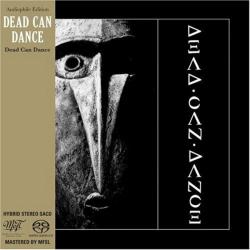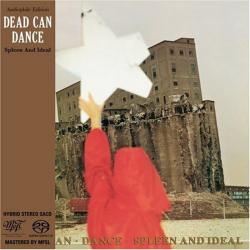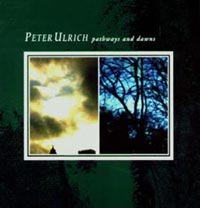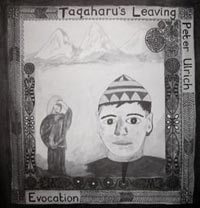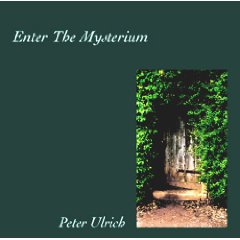Dead Can Dance Reissue Story by Peter Ulrich
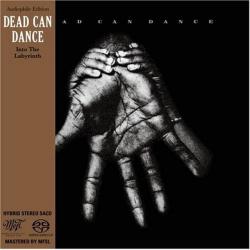
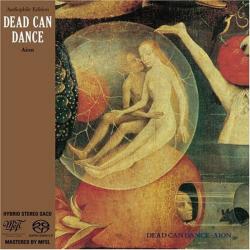
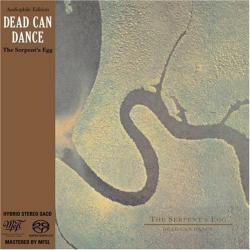
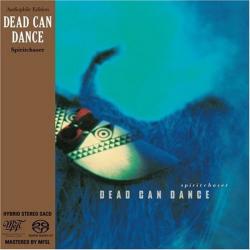
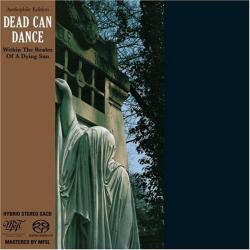
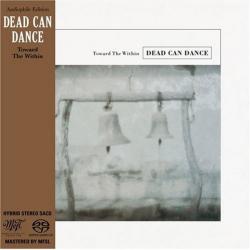
4AD Releases Mobile Fidelity Sound Lab
Remastered Editions of Nine Titles
in the Dead Can Dance Catalog on SACD!
These albums were remastered by MFSL (Mobile Fidelity Sound Laboratory), one of the most respected audiophile labels in the U.S.A.
They are in the hybrid stereo SACD format and are packaged in Japanese paper sleeves which replicate the original U.K. vinyl releases,
including replica original inner sleeves and new additional booklets with lyrics, album labels and other images.
You may be wondering how on earth did MOFI and Dead Can Dance get together?
Well, here’s how this project got started, straight from Peter Ulrich.
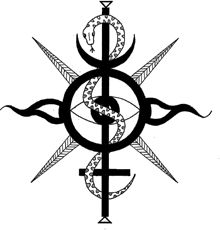
Hi – I’m Peter Ulrich, former drummer/percussionist with Dead Can Dance.
I’ve known United Home Audio’s Greg Beron for several years now, and we’ve become good friends.
Greg has been a great supporter and promotor of my music, and we’ve worked on a number of initiatives together.
One such project – which Greg initiated – has recently culminated in the release of the Dead Can Dance back catalogue – fully re-mastered by US leaders in this field Mobile Fidelity Sound Lab (MOFI) – in exceptionally high quality hybrid SACD and due out soon high-grade vinyl formats.
This has created a lot of interest in the audiophile community, and Greg thought it would be of interest to many of you to know the story of how it came about, so he’s invited me to write this piece for the United Home Audio website.
As devotees will be aware, DCD is essentially the duo of Brendan Perry and Lisa Gerrard.
Although there were five of us who originally signed to the UK’s 4AD label as DCD in 1983, it was always Brendan and Lisa who created the essential sound of DCD from the outset.
The first recording contract lasted for three years, and thereafter DCD officially became just Brendan and Lisa as the artists signed under that name.
But by this stage DCD had already become more of a ‘project’, rather than a ‘band’, with Brendan and Lisa as the central catalyst, plus a pool of musicians from where they could summon whoever was needed for particular recording sessions or touring.
I was privileged to be involved in some of the recording and nearly all live performances until the end of 1990 when family commitments meant I could no longer commit to the touring requirements.
I continued to maintain close contact with Brendan in particular, and was invited back to participate in recording sessions in 1995 for DCD’s last studio album – Spiritchaser.
Despite my close involvement and participation in DCD over many years, I never quite got over feeling like a big fan who got the ultimate experience of actually performing in the band.
When Brendan and Lisa announced the end of DCD in 1998, I mourned along with the rest of the fanbase – and similarly, when they announced they would reunite and tour again in 2005, I was as surprised (well, gobsmacked actually) and delighted as everyone else.
It was only then that we became aware of the DCD phenomenon that had occured – particularly in the US – during the interim.
When tickets were put on sale for the North American leg of the 2005 tour, the demand was amazing and the promotors had to quickly re-schedule to larger venues.
I can remember Brendan telling me on the phone that DCD had been booked to play the Hollywood Bowl to 18,000 people performing with the LA Symphony Orchestra.
We both just went… “Wow!” (or something like that).
The American tour took place in late 2005, but earlier that year DCD were on tour in Europe and I had met up with Brendan and Lisa when they played their two shows in London in early April.
The European Tour had also been a great success, and the buzz from these shows was already generating excited anticipation in the US.
At around the same time, Greg was attending the “Stereophile Show” in New York City and in early May he e-mailed me to say that during the Show he had met up with John Bates of MOFI.
It came up in their conversation that Greg knew me and apparently John Bates became quite excited about a direct link to DCD.
To put this in context – particularly for the uninitiated – DCD’s 1993 album “Into The Labyrinth” is widely considered an audiophile classic and (so Greg tells me) can regularly be heard demonstrating top-of-the-range gear at the big audio expos.
John Bates told Greg he would love to set up the possibility of MOFI re-mastering “Into The Labyrinth” for release on 180g vinyl – he gave Greg his cellphone number and his parting shot was “get me that deal”.
Once Brendan was back home and recovered after the European tour, I spoke to him about the interest from MOFI.
He was quite happy to pursue the possibility and suggested I put it in the hands of Chris Sharp at 4AD’s London office.
In late July 2005 I e-mailed the background to Chris, who referred me on to Steve Webbon at 4AD’s parent company, Beggars Banquet.
Steve responded that they were already in discussion with MOFI in respect of other artists, but there had been no mention of any DCD titles.
However, he told me at that stage the DCD catalogue was locked into a licensing deal through Warner Brothers until June 2006.
It was considered unlikely that MOFI would want to negotiate a deal with Warners for a period of less than a year, so it was probably an opportunity to pursue once the catalogue rights reverted to 4AD/Beggars Banquet.
At that point, Steve told me, he would love to discuss re-mastering and releasing the entire DCD catalogue with MOFI.
He did, however, raise one other issue – that most of DCD’s catalogue is digitally recorded (only the early recordings up to the mid-80s were onto 2″ master tapes), while MOFI mostly work with back catalogues in analogue format.
There was some doubt as to whether “Into The Labyrinth”, for example, could be significantly improved.
Nevertheless, Steve was happy for us to put him directly in touch with John Bates at MOFI, which Greg and I organised.
We continued to monitor the situation after that.
Greg maintained occasional contact with MOFI – initially through John Bates, and latterly with company owner Jim Davis – while I heard snippets of news through Brendan.
Time drifted past, the Warners contract expired, rights reverted, 4AD/BB and MOFI negotiated terms and finally, some three years after Greg set this ball rolling, the issue of the new re-mastered formats through MOFI was announced for August 2008.
As far as I know, the general concensus is that the re-masters are great – and the SACD formats are naturally appreciated by the audiophile community, however being hybrid discs the CD layer is quite remarkable as well.
While even the later albums are considered to have benefitted, it is of particular interest to me personally that the first (eponymously titled) Dead Can Dance album has been re-mastered and re-released in a high quality format.
I have so many special memories from that time when we were starting out, going in the studio and out on tour for the first time, signing our first recording deal, doing our first interviews, getting our first reviews, etc.
We were thrilled to release our first album, but it was tempered by the fact that we’d had a lot of problems at the mixing and production stages and we were disappointed with the overall sound – which was muffled and lacking dynamics, in complete contrast to the epic production soundscapes which would become Brendan’s hallmark in years to come.
There are some great songs on the first DCD album – songs that I loved performing live – and I’m very happy that it’s been possible to breathe some new life into those early recordings.
Plus, I think a lot of DCD’s US audience will discover these songs for the first time through these re-issues.
DCD had already released five of its seven studio albums when we first toured the US and Canada in 1990 (my final DCD tour).
Subsequent licensing through Rykodisc and then Warners saw the release of a retrospective compilation album – “A Passage in Time” – and the “Toward The Within” live album in addition to the 90s studio albums – “Into The Labyrinth” (1993) and “Spiritchaser” (1996) – but DCD’s first album and “Garden of the Arcane Delights” EP, both released in 1984 (and both entirely analogue recordings), remained off the radar for all but the most ardent American DCD collectors.
So, hopefully the entire DCD catalogue will now loom large in audiophile circles for many years to come, and a wider selection will be heard in the demo rooms at the big equipment shows.
I know Greg and the guys at United Home Audio will continue to promote ever-wider exposure, not only of the DCD recordings, but also of my solo work – support which I’ve been immensly grateful for over the years.
Greg has single-handedly raised the profile of the song “The Springs of Hope” from my “Pathways and Dawns” album (Projekt, 1999) to audiophile classic status – largely thanks, of course, to Brendan’s great production.
At CES 2006 in Las Vegas, United Home Audio issued a special freebie limited edition (1,000 copies) 4-track CD comprising “The Springs of Hope” plus three tracks from my “Enter The Mysterium” album (City Canyons Records, 2005) – and Greg tells me these also still make regular appearances in the demo rooms at the major audiophile shows in the US.
Thanks for reading – hope you found it interesting.
If you have any feedback, or any questions arising from the above, please e-mail Greg at United Home Audio and he will pass your mail on to me.
Otherwise, enjoy those recordings!
Best wishes,
Peter.
